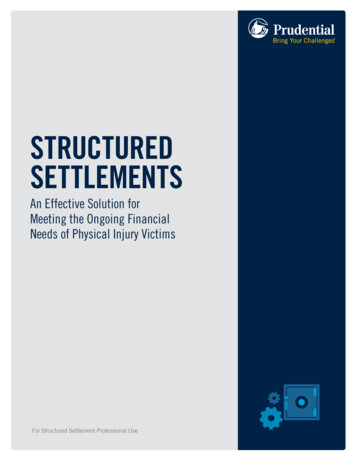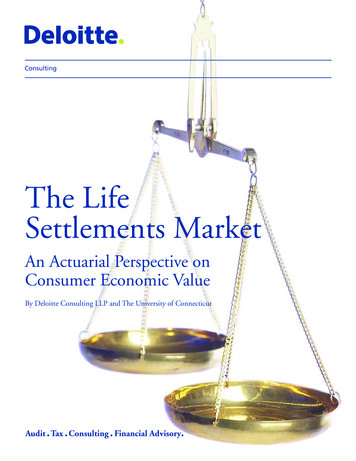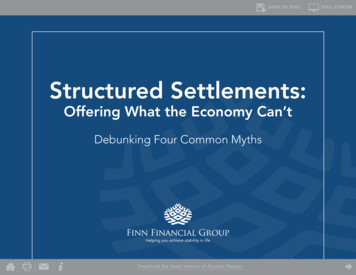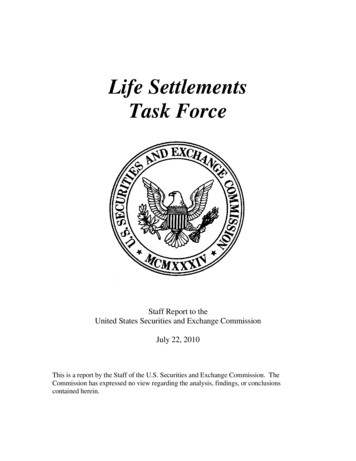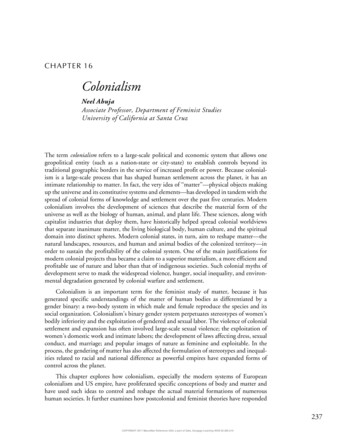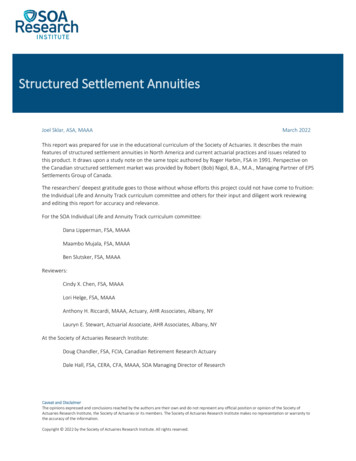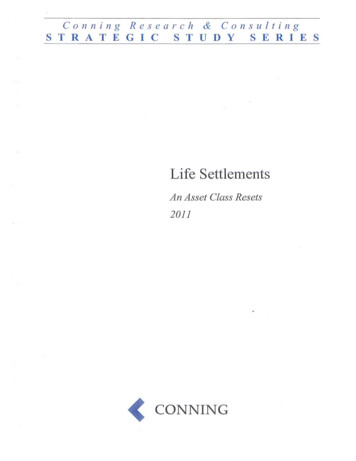
Transcription
Resecc ch c ConsZCltingS 'I' R A T E G I CS T U D YE E R I E SC012121ngLife Settlements n Asset Class Resets2011CONNING
IC ll SettlementsAlz Asset Clress Izeset. OO Conning Research &Consulting,2011This research publication is protected by the copyright laws ofthe United States(17 U.S.C. § 101 et seq.)and may not be duplicated, in whole or in part, without the prior written consent ofConning Research &Consulting
This pa blication has been ps epa edfof and clistribzrted exclusively tospecific cliei7ts of Conning Research & Consarlting("Conning).Fzri ther distf ibzrtion, sale, or reproduction, in whole or' in part, and byany means, is prohibited. Statements and information in this reportwe e compiled from sots ces that we consider to be reliable or areexpressions of oz r opinion. The report is not if tended to be complete,and we do not gaiarantee its accuracy. It does not constit2rte and mzrstnot be considered investment advice. TVith offices itz Hartford, Ne1vYork, Dublin, London, and Cologne, Conni g is a portfolio company ofthe finds maf aged by Aquiline Capital Par tne s LLC ( Aquiline'), aNew York-basedprivate ec Zrityfirm.A 7nual statement information contained herein -vas in part basedon the NAIL Annzral Statement Database, via National Unclertivr iterInsurance Data Services/Highlit e Data.Conning Reseaf ch & Consiclting!10927Conning Research & Conszrlting publishes u nrmber ofinszn anceindarstry r esearcl publications, incZzrding its "Inszr nnce SegmentReports" semi-annatal Zine-of-business revietivs; its "Fo ecast &Analysis," which offers a fo tinard look at tl e industry; and its wellInzotivn "Strategic Stz cly" series on key prodarcts and isszres ofinte est.All ar e available on a sa bscr iptiort basis and thr ozrgl oarr web-basedresea ch archive Conning Librnry.For more irrfor mation regardif g Conning s ptrblicatio»s andservices, please visit tiv v v.con»ingr esearch.com.OO Conning Research &Consulting,2011This research publication is protected by the copyright laws oftl e United States(17 U.S.C. § 101 et seq.)and may not be duplicated,in whole or in part, without the prior written consent ofConning Reseazch &Consulting
; CONNINGLife Sel:tlementsAn Asset Cl cs besetsTA L K CON fENTS1.In roduc :io . 2.ExecL tive Summary . 73.IVlarket Review and Forecast . 15 Life Settlement Market Review Cot nii gAnnzral Estimate Estimate Methodology Key Long-Term Drivers Credit Markets Conszn zer Demand Regailatofy O ersight The Ter tiatyMarket Life Expecta»cy Estimates Ltfe Insarrer Respo ZSes 4Conning's Life Settlement Market Forecast G oss Market Pote»tial Forecast Net Maf ket Potential Fo ecast In ForceLife Settlements Forecast Am a al Yolzm e Forecast 4.SummaryThe Policy Seller's Market Landscape . 35 An Unchanged Opportunity The Continued Appeal ofLife Settlements Younger Policies Have Greater Appeal Insurers Respond to the Impact of STOLI and Life Settlements STOLI Cases Contii a e to Surface Insurer Efforts to Mitigate STOLIn7ayImpact Emerging Inszn er Opportzmities Not Anothe Viatical Market The Sell-Side Market Reboots Policy Ow zer Away eness Increases Agent Awrn eness Increased PolicyC itet ia Tighten Ot-vne Crite ia Tighten Life Settleme 7t Transparencyb creased STOLIis a Redarced Factor After the Reboot 5.Summary.The Investor's Market Landscape. 63 The Investor's Opportunity Remains The Attf-action ofLow Correlation Remains Con mandi ag a Bzryer'sPremiznn Conning Reseazch &Consulting,2011. This research publication is protected by the copyright laws ofthe United States(17 U.S.C. § 101 et seq.) and may not be duplicated,in whole or in part, without the prior written consent ofConning Research &Consulting.3
; CONNING The Investment Side Reboots Life Expectancy Risk Better Understood Contestability Risk Redzrcecl Afterthe Im estn7ent Reboot SummaryB Cocuvng Reseazch &Consulting,2011. This research publication is protected by the copyright laws ofthe United States(17 U.S.C. § 101 et seq.) and may not be duplicated,in whole or in part, without the prior written consent ofConning Reseazch & Consulting.
CONNING1.IntroductionAfter the perfect storm that hit the life settlement market in late 2008 and early 2009, abuyer's market emerged. Aimual transaction volume decreased as capital retreated fromthe life settlement market. Conning vv ote in 2010 that a prolonged delay in the return ofcapital could impact the fuhue size ofthe life settlement as a viable asset class.In 2011, the buyer's market continues, at least when it comes to new life settlements. Asa result, in 2011, Conning began to examine the affect this is having on the firture growthand development of life settlements.Looking at the development of the life settlement market, we see an asset class that isresetting itself in terms of annual volumes to an earlier era. That said, the fundamentalappeal of life settlements for certain policy owners remains. This appeal translates into acontinued demand by individuals to settle their policies. The ongoing question remains asto whether enough investors will retain to meet that demand.This study reviews the life settlement market as it resets and looks ahead at thechallenges and opportunities it faces. We review the cui7 ent market and provide our forecast of how the lifesettlement market may develop over the medium-term. We analyze how the landscape has changed for policy sellers and buyersfrom the high-point of 2007/2008 We examine how insurers have responded to STOLI and the impact thoseresponses may have on future grovvth opportunities. We explore the cui ent and emerging regulatory landscape and consider itsimpact on life settlement providers, policyholders, and investors.A History of Life Settlement ResearchConning has followed the development of the life settlement market since 1999 becauseit represents the convergence of several themes we believe confront the broader lifeD Conning Research &Consulting, 2011. This reseazch publication is protected by the copyright laws ofthe United States(17 U.S.C. § 101 et seq.) and may not be duplicated, in whole or in part, without the prior written consent of Conning Reseazch &Consulting.
1. Introduction CONNINGinsurance industry. First, policyholders increasingly demand products and services thatprovide consumer flexibility. The life settlement market response has been to meet thesedemands. This increasing consumer optionality creates a second theme, an accompanyingincrease in the level of risk in accurately pricing products. Finally, life settlementsrepresent the continuation of third-party providers assisting and influencing policyholderbehavior, without concern for the best interest ofthe insurer.Our prior studies include:1999Viatical SettleT 2ents—The Emeigi zg Secondary Mc rizetfor Life Insurance Policies2003Life SettlementsAdditional Pressure on Life P ofits2006Life Settlements—The Concept Catches On2007Life Settlement Mccr ket—Increasing Capital and b vestor Demand2008Life Settlement Mai ket—New Challenges to Grog-vth2009Life SettlementsA Bzryer s' MarketfoT Now2010Life Settlements—The Market Stabilizes as Insurer bnpczct G ows6 Conning Research &Consulting,2011. This research publication is protected by the copyright laws ofthe United States(17 U.S.C. § 101 et seq.)and may not be duplicated,in whole or in part, without the prior written consent ofConning Reseazch &Consulting.
CONNINGExecutive Summary2.After the perfect stoi7n that hit the life settlement market in late 2008 and early 2009, abuyer's market emerged. In 2010 and into 2011, capital has yet to return to the levels of afew years ago. As the life settlement industry adjusts to a prolonged buyer's market, itsparticipants find themselves operating in a changing landscape in tei rns of acceptablepolicy criteria, expected returns, regulation, and competition.Market Review and ForecastConning estimates life settlement sales decreased for the third consecutive year in 2010.Capital contimies to remain skittish about returning to this asset class, and investors arefocused on acquiring distressed portfolios rather than purchasing new policies. Given thecombination of death claims and lapses on settled policies, the estimated in force amountof life settlements barely increased over 2009. Based on our analysis of the life settlementmarket, we estimate that in 2010: Approximately 3.8 billion worth of U.S. life insurance face values weresettled. Approximately 36 billion of U.S. life settlements were in force at yearend.To understand where this asset class is heading, it is important to look back over its firstdecade. When we look at the period of2002 tluough 2010, we see four distinct periods ofchange in annual volumes. The first period, 2002 through 2004, represents the emergenceof this new asset class from the ruins of the viatical settlement market. Annual volumesincreased as investors and policy owners began to learn about life settlements. In 2005and 2006, an influx of capital, primarily from Gei7nan investors seeking atax-advantagedinvestment and the development of STOLI (stranger-originated life insurance),significantly increased annual sales.In 2007 and 2008, an influx of capital combined with growing awareness of lifesettlements among brokers and policy owners (and the continued sale of STOLI policies)increased annual volumes to a high point of 12 billion. This created a seller's market as Conning Research &Consulting,2011. This reseazch publication is protected by the copyright laws ofthe United States(17 U.S.C. § 101 et seq.) and may not be duplicated, in whole or in part, without the prior written consent ofConning Research &Consulting.7
2. Executive Summary CONI TINGinvestors sought more policies to build portfolios. Changes in life expectancy and theeconomic and credit crisis led to a collapse in annual volumes in 2009 and 2010, and theemergence of a buyer's market for policies.Looking ahead, Conning forecasts that the annual volume of life settlements, in faceamounts, will average around 4 billion per year. In essence, the asset class has resetitself to its initial growth period of2002 tluough 2004.Observed then from a distance, life settlements seem to be entering a new phase that maywell result in smaller volumes over the short-term. Meanwhile,the fundamental appeal oflife settlements remains. Life settlements continue to offer a value added benefit topolicyholders as long as insurers are unable to provide cash surrender amounts thatreflect a policy's mortality-adjusted economic value. Life settlements also retain theirattraction as an alternative asset class for investors due to the low coinelation with equitymarkets and competitive returns.Given cui7ent economic conditions and investor sentiment, life settlements continue to bea small asset class. The number of policies that could be settled will continue to grow aspolicy owner awareness increases. However, the level of capital needed to meet thatdemand may not be available. As result, annual volumes will remain relatively flat overthe forecast period. This creates a challenge to the in force amount because newsettlements may not be sufficient to replace the amount of policies either lapsing or filingdeath claims, eventually reducing the amount of settled policies.Over the medium- and long-term, the asset class's largest growth challenge will beattracting more capital to purchase new policies, rather than seek vulture-investingopportunities among distressed portfolios. Meeting that challenge will determine the assetclass's ultimate size.The Investor's Market LandscapeAs with all types of assets and the markets where they are traded, life settlements exist ina changing landscape. If the life settlement market is resetting itself, in terms of annualface amount settled, to the 2005/2006 era it is useful to understand how the cui7entlandscape is both similar and different from that era. The comparison between thesesimilarities and differences may provide some indication of what challenges have beeng Conning Research &Consulting,2011. This research publication is protected by the copyright laws ofthe United States(17 U.S.C. § 101 et seq.)and may not be duplicated, in whole or in part, without the prior written consent ofConning Research &Consulting.
, CONNING2. Executive Summaryresolved and which remain. This chapter explores the similarities and differences fromthe policy seller's point of view.An Unchanged OpportunityHave life settlements lost their fundamental appeal? Are life settlements destined to gothe way of viaticals? The short answer is no. The appeal of life settlements to policyowners stems from the relatively higher amounts they receive for selling their policiesthan for surrendering or lapsing. That difference is the result of the low sut ender valuespriced into an insurance policy.It is this higher payout to policy owners whose cash value policies have not been in forcefor a significant period that is the appeal of life settlements. In essence, life settlementsmeet a need that insurers cannot match. Even if nonforfeiture laws allowed for medicallyunderwritten surrenders, the insurers incurs costs associated with acquiring a contract thataffect its ability to match the offer. Those costs had not been recouped, and paying thehigher sui7ender value on younger policies creates an immediate loss.If policy owners of relatively young policies were thinking of either lapsing orsurrendering their policies, then it made economic sense for them to seek the highestpossible value for those policies. Because nonforfeiture regulations do not permit insurersto differentiate cash surrender values based on current life expectancy, creating theopportunity for life settlement providers to offer more for a policy, on a selective basis,than the insurer is able to pay,the appeal of life settlements remains.Insurers Respond to the Impact of STOLI and Life SettlementsThe length of time since a life settlement policy was issued has another implication onthe future of the life settlement market. If the majority of the policies settled in the pastwere within a few years of issue, it may be some indication that STOLI sales played amuch greater role in the life settlement market than suspected. For example, the lifesettlement industry has stated that its target audience is a policy owner who no longerwants or needs their policy. However,if 51% of policies were settled within four years ofissue, this would appear to challenge that point. Either these policies contain manySTOLI sales, or agents are selling policies (especially high face value policies) to olderindividuals who are either unable to continue premium payments or perhaps never neededthe product in the first place. Conning Reseazch &Consulting,2011.This reseazch publication is protected by the copyright laws ofthe United States(17 U.S.C. § 101 et seq.) and may not be duplicated,in whole or in part, without the prior written consent ofConning Research R Consulting.9
2. Executive Summary CONNINGInsurers are malting efforts to monitor policies for STOLI. In some cases, this monitoringhas led to rescission of the policy or the contestation of claims. The Wall Street Joz r nalreported in 2010 that insurers had filed more than 200 civil law suits in various statesover alleged STOLI transactions. This monitoring has also led some insurers to reportsuspected STOLI cases to legal authorities, which in tuna, has led to criminal chargesbrought against the individuals involved in the STOLI scheme. States are also taking anactive role in combating STOLI sales by implementing anti-STOLI legislation as well asfiling charges in cases of suspected fraud.However,the existence of so many STOLI cases may indicate a potential weakness in theunderwriting and approval process for high face value policies. In these cases, somehow,the insurer issued policies that it later contested in court. Either the agent committedfraud and it was not detected during underwriting, or it was detected during theunderwriting process, yet approved for issue anyway.Two things are troubling if insurers are issuing high face value policies after being awareof potential STOLI issues. First, these policies, relative to smaller face value policies,have a larger financial impact on the insurer if the insured dies before policy costs arerecouped. Second, problems in the underwriting and approval process that allow potentialSTOLI cases to be issued may hinder later efforts to contest any clairris.What does this mean for policy sellers as the life settlement market reboots? Mostimportantly, the length of time after policy issue matters. If the policy has been in forcefor a long period, insurers may be less likely to challenge the death claim or sale. On theother hand, policy owners who want to sell their policies relatively quickly after issuemay find their policies contested by insurers.Mitigating STOLI may also impact the ability of insurers to realize new sales from anemerging market opportunity. The growth in new insurance sales among olderindividuals is greater than for younger customers. In addition, these older insureds tend tobuy high face value policies. However, insurers may well be tightening their underwritingprocess to identify STOLI during application and protect the insurer's ability tosuccessful sue after issue. This tighter underwriting can lead to delays in policy issuance,which can frustrate the agent and the customer.1 D Conning Research &Consulting, 2011. This reseazch publication is protected by the copyright laws ofthe United States(17 U.S.C. § 101 et seq.) and may not be duplicated,in whole or in part, without the prior written consent of Canning Reseazch &Consulting.
;;' CONNING2. Executive SummaryThe Sell Side Market RebootsThe life settlement market, in 2005, was a wild west for policy owners. It was largelyunregulated. Transparency about the fees and commissions taken from the offering pricefrom investors was lacking. As a result, policyholders were at a disadvantage inevahiating the true value of their policy. Both agents and policyholders were largelyunaware about the existence of life settlements and the settlement process. Investors wereselective in the types of policies they purchased,the face amounts, and health criteria.The sell-side is no longer the wild west of 2005. Like the old frontier towns, civilizationhas arrived and tamed the west. Consumer and agent awareness of life settlements hasincreased. Once the existing pool of settled policies has been repurchased, lapsed, or haddeath claims filed, those investors that remain will return to buying policies.As investors return to life settlements, they will find clearer, and more stable, regulation.These returning investors will be dealing with better-educated consumers and agents. Atthe same time, policyholders will find that the criteria investors used to judge the appealof a policy has changed. Having focused on high face values and older (and sicker) policyowners when the life settlement market emerged, investors relaxed those criteria when itwas at its height in 2007 and 2008. However,the buyer's market has led to the tighteningof these critei7a. As a result, policyholders may find themselves with less opportunity tosell their policies.From the perspective of life settlement investors, the events of 2008 and 2009 changedtheir landscape. The risks of inaccurate life expectancies and dependence on leveragebecame apparent. Larger institutional investors, especially investment banks, exited theasset class. Taxation changed causing funds to relocate their operations. Investment fraudcontinued to rear its head, causing some degree of concern among potential newinvestors. These factors came together to create the current buyer's market. However, forthose investors that continue to participate there are several key points that point towardsa more positive future.1 to ' opportunity l ainsLife settlements attracted investors for two main reasons. First, the asset class has a lowcorrelation to fixed-income and equity securities. Second, life settlements still offerinvestors the potential to generate a competitive retain.8Conning Research &Consulting,2011. This reseazch publication is protected by the copyright laws ofthe United States(17 U.S.C. § 101 et seq.) and may not be duplicated,in whole or in part, without the prior written consent oFConning Reseazch &Consulting.11
2. Executive Summary CONNINGLife settlement investors view insurance as an asset with a low correlation to equity orinterest rate changes. For investors who have a large portion of their assets in equity ordebt, adding life settlements as an alternative investment is one way to reduce aportfolio's exposure to sudden downturns in the stock or bond markets. Low correlationis not the same, however, as noncoi- elation.Lower interest rates affect the premium optimization used by life settlement investors.Life settlement investors use the premium flexibility of UL (universal life) to increasetheir return by "optimizing" the premiums they pay to the insurer.Life settlements continue to offer the potential to generate competitive returns forinvestors. However, the buyer's market has brought forth two distinct markets forpolicies. The secondary market involves the purchase of policies from the individualswho initially took the policy out. The tertiary market involves the purchase of alreadysettled policies, either singularly or in portfolios, from other life settlement investors.Both markets command a premium over similar risk-free rates, however, the secondarymarket appears to offer a higher premium for investing in new policies.People considering allocating capital to life settlements are aware that they are at somedegree of risk of losing their investment. Therefore, life settlement investors eitherconsciously or subconsciously require an investment risk premium over a comparablerisk-free investment. Life settlement investors in the secondary market also appear to becommanding a buyer's premium due to the lack of investor capital available to purchasepolicies in the secondary market.In the tertiary market, the supply of capital interested in buying already settled policiesand portfolios is creating enough competition for already settled policies and portfoliosthat investors need to reduce their IRRs (internal rates of return) and by extensionincrease their offer in order to win business. Given that LEs (life expectancies) and faceamounts are comparable between the secondary and tertiary markets, any advantagefound in bottom fishing for bargains among already settled policies or portfolios may bedeclining.IZ Conning Research &Consulting,2011. This research publication is protected by the copyright laws ofthe United States(17 U.S.C. § 101 et seq.)and may not be duplicated, in whole or in part, without the prior written consent oFConning Research &Consulting.
CONNING2. Executive SummaryThe Investment Side RebootsAs the life settlement market reboots, investors will continue to find an opportunity tomake returns that are higher than other fixed income investments. Returning lifesettlement investors will understand life expectancy risk better. They will also face alegal landscape that has seen several recent cases that strengthened their ability to receivedeath benefits. In addition, if the life settlement market remains small in terms of thenumber of buyers, then IRRs may remain high.Investors rely on life expectancies from underwriters, and often from snore than one, as amajor pricing component. Those life expectancies flow tluough to portfolios, where fundmanagers use them to calculate policy values over time. As the life settlement marketreboots, investors will continue to remain concerned about the accuracy of lifeexpectancies. However, efforts to standardize life expectancy methodologies shouldcontribute to a reduction of concern among some investors.Several court rulings in 2010 and 2011 limited the ability of life insurers to contest deathclaims. The life settlement industry has engaged with life insurers over policy rescissionand denial of death claims since it began.Life insurers have always resisted some death claims. However, with the rise of lifesettlements, some insurers have been more forceful in resisting suspected STOLI andother life settlement claims. Evidence ofthis can be seen in comparing the dollar amountof resisted claims for the ten insurers who have been the greatest focus of life settlementinvestors against the remaining industry. Against this background of an increase inresisted claims, recent court rulings have favored the life settlement industry. These casesare a positive development for investors.What will be some broad investor themes that might emerge as the life settlement marketreboots?The life settlement market of 2006 tluough early 2008 saw several large investmentbanks enter the space. After the credit crisis and recession of late 2008 and early 2009,many left for a variety ofreasons. Their withdrawal was a major factor in the reduction incapital to buy policies. As of 2011, the gap created by the withdrawal of those largeinvestors has not been filled.D Conning Research &Consulting,2011. This reseazch publication is protected by the copyright laws ofthe United States(17 U.S.C. § 101 et seq.) and may not be duplicated,in whole or in pazt, without the prior written consent of Conning Reseazch &Consulting.13
' CONNING2. Executive SummaryInvestors can purchase settlement portfolios for only so long. At some point, theseportfolios will be held until the policies in the portfolio lapse or a death claim is paid onthem. This will cause capital to return to buying new policies. As it does, competition forpolicies will lead to higher offers being made,lowering the return for investors.Finally, a smaller market, in terms of the number of players and the capital they bring,may benefit life settlement investors already in the market. The less capital availablemeans that life settlement investors can contimie to demand a capital premium in additionto their risk premium.GlossaryLife settlements are an emerging asset class. As a result, the terminology used in thismarket is still evolving. For the purposes of this study, Conning will use the followingterminology:Life Settlement GlossaryTermDefinitionPhysical Life PolicyA life insurance policy that is underwritten and issued by an insurance company on the lifeof an insured.Traditional Life SettlementThe purchase of a physical life policy by a buyer on an investor's behalf.Extracontt actual LoanLoaning an individual an amount in excess of their physical life policy's cash surrendervalue, and using that policy's death benefit as collateral.Synthetic Life PolicyA virtual policy created by investment firms based on data from a pool of lives.Measuring LifeAn individual whose demographic and health data are used to price a synthetic policy andwhose death triggers the payment of a synthetic death benefit. This is similar to the insuredin a physical life policy.Synthetic Life SettlementThe purchase of a synthetic life policy by a buyer on an investor's behalf.Gross Market PotentialThe total face amount of all policies that meet life settlement buyer criteria, regardless ofwhether the policyholder wants to sell.Net Market PotentialThe percentage of all policies that meet life settlement buyer criteria where thepolicyholder is likely to consider selling.In Force AmountThe cumulative face amount of all life settlements where the insured is still alive.Annual VolumeThe face amount of all life settlements transacted in a given year.BuyerAn institution that purchases policies on a fund manager or investor's behalf.Fund ManagerAn institution or individual that manages a portfolio of life policies on behalf ofinvestors.InvestorAn institution or individual that.supplies capital to purchase life settlements.Secondary MarketA market where the original policyholder sells their policy to a buyer.Tertiary MarketA market where buyers, or fund managers, resell individual policies or portfolios ofpolicies.14 Conning Research R Consulting,2011. This research publication is protected by the copyright laws ofthe United States(17 U.S.C. § 101 et seq.) and may not be duplicated,in whole or in part, without the prior written consent of Conning Research &Consulting.
CONNINGMarket Review and Forecast3.Conning estimates that life settlement sales decreased for the third consecutive year in2010. Capital continues to remain skittish about reh ining to this asset class, and investorsare focused on acquiring distressed portfolios rather than purchasing new policies. Giventhe combination of death claims and lapses on settled policies, the amount of in force lifesettlements barely increased over 2009. Based on our analysis of the life settlementmarket, we estimate that in 2010: Policyholders settled approximately 3.8 billion worth of U.S. lifeinsurance face values. Investors held approximately 36 billion ofin force U.S. life settlements atyear-end.The following sections analyze the 2010 U.S. life settlement market and its potentialgrowth over the coming decade. Subsequent chapters analyze the factors and issuesinfluencing the cui7ent market and its fuhire development.Life Settlement Mar{ret ReviewQuestions regarding the cui ent size of the life settlement market are among the mostfrequent queries we receive at Conning. There is no official source of the information, orindependent party, to which all life settlement providers report the volume of policiespurchased. As a result, Con
Based on our analysis of the life settlement market, we estimate that in 2010: Approximately 3.8 billion worth of U.S. life insurance face values were settled. Approximately 36 billion of U.S. life settlements were in force at year-end. To understand where this asset class is heading, it is important to look back over its first decade.
